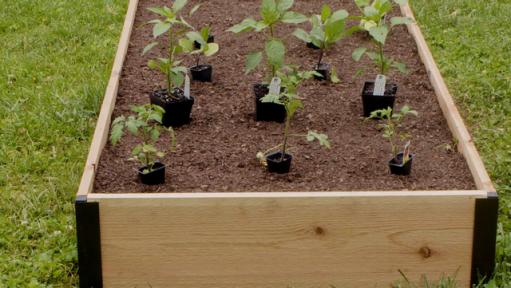Raised planter beds are a great way to grow plants in a controlled environment while reducing strain on your back. By elevating the soil level, these beds provide better drainage and prevent soil compaction. This makes it easier for plants to thrive and for you to maintain your garden.
Additionally, raised beds can offer protection from pests and can be designed to suit any outdoor space, from small gardens to large yards. Whether you're a gardening enthusiast or a beginner, raised planter beds are a practical and aesthetic addition to any outdoor area.

Credit: www.gardeners.com
Choosing The Right Location
When determining where to place your raised planter beds, consider sunlight exposure, accessibility, and convenience.
Sunlight Exposure
Ensure your raised planter beds receive at least six hours of sunlight per day.
Accessibility And Convenience
- Locate the beds near a water source for easy watering.
- Choose a spot that is easily reachable for planting and harvesting.
- Keep them close to your house or kitchen for quick access to fresh produce.
Selecting Materials
Selecting the right materials is crucial for building durable and long-lasting raised planter beds. When it comes to materials, you have various options to choose from.
Wood Options
- Cedar: Resistant to decay and insect damage.
- Redwood: Naturally rot-resistant and visually appealing.
- Pressure-Treated Pine: Economical choice but ensure it's safe for gardening.
Alternative Material Considerations
- Metal: Provides a modern look but may heat up in the sun.
- Concrete Blocks: Durable and can be stacked to create raised beds.
- Recycled Plastic: Environmentally friendly option with good durability.
Design And Construction
When it comes to building raised planter beds, the design and construction play a crucial role in ensuring the success of your garden. The appropriate bed height, drainage considerations, and proper building techniques are essential factors to consider. Let's dive into the details of these key elements for the effective design and construction of raised planter beds.
Proper Bed Height
The proper height of raised planter beds is vital for the health of your plants and the ease of gardening. Gardening experts generally recommend a height of 18 to 24 inches for raised beds. This height provides sufficient depth for plant roots to grow, improves soil quality, and reduces strain on the gardener's back during maintenance activities.
Drainage Considerations
Effective drainage is crucial to prevent waterlogging and ensure the well-being of your plants. Incorporating well-draining materials such as gravel or sand at the bottom of the bed can help prevent water accumulation. Additionally, creating drainage channels or holes in the bed structure can facilitate proper water drainage and prevent root rot.
Building Techniques
When it comes to building raised planter beds, there are several techniques to ensure a sturdy and durable structure. Utilizing materials such as rot-resistant wood, composite timbers, or galvanized steel can enhance the longevity of the beds. Moreover, employing corner brackets or strong joinery techniques can provide additional stability to the bed structure, especially if it's large or tall. Treated lumber can be used for construction, but ensure that it’s safe for growing edible plants.
``` In addition, it’s essential to prepare the garden soil properly for the raised beds. Amend the soil with organic matter like compost and ensure it is well-drained for optimal plant growth. By considering these design and construction aspects, you can create a sturdy and productive raised planter bed for your garden.:max_bytes(150000):strip_icc()/bedroom-paint-color-ideas-2000-fb11fb605d4142f1813ea930e2a1ad48.jpg)
Credit: www.realsimple.com
Soil Selection And Preparation
When it comes to building raised planter beds, one of the most crucial aspects is soil selection and preparation. Using high-quality soil and ensuring it is properly prepared will provide the ideal environment for your plants to thrive. In this section, we will discuss the components of quality soil, the optimal ratios for a soil mixture, and the steps to preparing the bed.
Quality Soil Components
A successful raised planter bed begins with high-quality soil components. These components play a vital role in providing the necessary nutrients and drainage for your plants. It is important to choose soil that is rich in organic matter.
Some of the key components to consider for your soil mixture include:
- Topsoil: Provides the essential nutrients and minerals required for plant growth.
- Compost: Enhances soil structure, improves water retention, and promotes beneficial microbial activity.
- Peat Moss: Helps retain moisture in the soil and improves aeration.
- Perlite or Vermiculite: Enhances drainage and prevents soil compaction.
Optimal Soil Mixture Ratios
While the exact ratios may vary depending on the specific needs of your plants, a general guideline for a successful soil mixture ratio is:
| Component | Ratio |
|---|---|
| Topsoil | 50% |
| Compost | 30% |
| Peat Moss | 10% |
| Perlite or Vermiculite | 10% |
These ratios ensure a balanced soil mixture that provides the necessary nutrients, drainage, and moisture retention for healthy plant growth.
Preparing The Bed
Once you have selected your soil components and determined the optimal ratios, it's time to prepare the bed for planting. Follow these steps to ensure the bed is ready:
- Clear the area: Remove any weeds, grass, or debris from the bed.
- Loosen the soil: Use a garden fork or tiller to break up any compacted soil and remove rocks or large clumps.
- Add soil mixture: Spread the prepared soil mixture evenly across the bed, making sure it is level.
- Water the soil: Lightly water the soil to moisten it, but avoid oversaturation.
By following these steps, you create an optimal environment for your plants, ensuring they have the best chance of thriving in your raised planter beds.
Planting And Maintenance
Once you have built your raised planter beds, it is time to start planting and maintaining your crops. Choosing suitable crops, providing adequate watering and fertilization, as well as implementing effective weed and pest control measures, are key elements to ensure the success of your raised planter beds. In this section, we will discuss each of these aspects in detail.
Choosing Suitable Crops
When selecting crops for your raised planter beds, it is important to consider their suitability for the raised bed environment. Certain crops thrive better in raised beds due to improved soil drainage and increased soil temperature. Some suitable crops for raised planter beds include:
- Leafy greens like lettuce, spinach, and kale
- Herbs such as basil, parsley, and cilantro
- Root vegetables like carrots, radishes, and beets
- Vining plants such as tomatoes, cucumbers, and beans (provide trellis support)
Watering And Fertilization
Proper watering and fertilization is crucial for the health and productivity of your crops. Raised planter beds tend to require more frequent watering compared to traditional garden beds, as the elevated height may result in faster moisture evaporation. To ensure optimal watering:
- Check the moisture level of the soil regularly by inserting your finger into the soil up to the second knuckle. If it feels dry, it's time to water.
- Water your raised planter beds thoroughly, aiming to moisten the soil to a depth of at least 6 inches.
- Avoid overwatering, as it can lead to root rot and other moisture-related issues. It's better to water deeply and less frequently.
In terms of fertilization, organic compost and well-balanced organic fertilizers are excellent choices for raised planter beds. Apply compost or fertilizer in spring before planting, and consider supplementing with liquid organic fertilizers throughout the growing season based on the specific crop requirements.
Weed And Pest Control
Weed and pest control is essential to protect your crops from competing plants and harmful insects. Here are some effective weed and pest control methods for raised planter beds:
- Regularly inspect your raised planter beds for any signs of weeds. Remove them promptly by hand, taking care to remove the entire root system.
- Mulching around your plants with organic materials like straw or wood chips can help suppress weed growth and retain moisture.
- Implement companion planting techniques to naturally repel pests. For example, interplant marigolds to deter aphids or plant onions to repel carrot flies.
- Consider using organic insecticides or homemade pest control solutions if necessary. Neem oil, insecticidal soap, and garlic spray are popular options.
By implementing suitable crop choices, providing proper watering and fertilization, and implementing effective weed and pest control measures, you can ensure the health and productivity of your raised planter beds. Maintaining these practices throughout the growing season will result in a bountiful harvest.

Credit: www.hgtv.com
Frequently Asked Questions On Building Raised Planter Beds
How Do You Build A Raised Planter Bed?
To build a raised planter bed, start by choosing a location, clearing the area of any debris, and marking out the dimensions. Then, assemble the frame using rot-resistant wood. Next, line the bottom of the bed with landscape fabric to prevent weeds.
Finally, fill the bed with a mixture of high-quality soil and compost.
What Are The Benefits Of Raised Planter Beds?
Raised planter beds provide several benefits, such as improved drainage, better soil quality, and easier access for gardening. They also allow for better control of pests and weeds, increased planting density, and extended growing seasons. Additionally, raised beds can be aesthetically pleasing and make gardening more enjoyable.
What Materials Can Be Used To Build Raised Planter Beds?
Various materials can be used to build raised planter beds, including wood, stone, concrete blocks, and even metal. Wood is a popular choice due to its availability, affordability, and ease of assembly. However, it's important to use rot-resistant wood, such as cedar or redwood, to ensure the longevity of the planter bed.
Conclusion
Building raised planter beds provides numerous benefits for your garden. By increasing accessibility and improving soil drainage, these beds can help you create a flourishing and low-maintenance garden space. With the steps outlined in this blog post, you can easily construct raised planter beds to enhance the productivity and beauty of your garden.

0 Comment to "Building Raised Planter Beds: Expert Tips for Maximum Yield"
Post a Comment